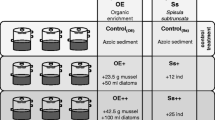Abstract
In a large marine lagoon (Thau lagoon, southern France) with a shellfish farming dominant eutrophication, the macrophyte communities were sampled by six transects of three depths (1.5, 2.5 and 5 m) and their characteristics (species composition, diversity and biomass) were described in relation to environmental and sediment parameters. With increasing eutrophication (total inorganic nitrogen, 0.140-0.295 mg l-1; dissolved reactive phosphorus, 0.045-0.110 mg l-1; and N/P atomic ratio, 3-22), silt fraction and shell fragments in sediments increased (12-93 and 0-65% dry wt respectively). Different types of macrophytic communities could be defined in the shallow zone (1.5-2.5 m) corresponding to four main and successive stages of degradation. A pure eelgrass stand (Zostera marina and Z. noltii) and an eelgrass community colonized by macroalgae were observed in SW sites and could be distinguished by their sedimentary features. In sites (NE) more affected by eutrophication (fine-textured sediment), available incident light determined two main seaweed communities: an Ulva rigida community, outside the shellfish tables, and a Gracilaria bursa-pastoris community in the shellfish tables (lower incident light).
Similar content being viewed by others
REFERENCES
Ben Maiz, N. (1986) Flore Agale (Rhodophyta, Phaeophyceae, Chlorophyceae, Bryopsidophyceae) de l'Etang de Thau (Hérault). PhD thesis, University Montpellier, France, 345 pp.
Calvet, L. (1905) Une esquisse de la faune et de la flore de la région de Cette. Travaux de l'Institut Zoologique de l'Université de Montpellier 15, 1–74.
Casellas, B., Picot, C., Illes, S. and Bontoux, J. (1990) Structure spatiale des sels nutritifs au sein d'un écosystème lagunaire: l'étang de Thau. Water Research 24, 1479–1489.
Cecere, E., Saracino, O.D., Fanelli, M. and Petrocelli, A. (1992) Presence of a drifting algal bed in the Mar Piccolo basin, Taranto (Ionan Sea, Southern Italy). Journal of Applied Phycology 4, 323–327.
De Casabianca, M.L. (1977) Résultats préliminaires des expériences sur la biodéposition en milieu lagunaire. Rapport de la Commission Internationale pour la Mer Méditerranée 24, 91–92.
De Casabianca, M.L. (1989) Dégradation des Ulves (Ulva rotundata, lagune du Prévost, France). Comptes rendus de l'Académie des Sciences Paris 308, 155–160.
De Casabianca, M.L. (1996) France — The Mediterranean Lagoons. In, Marine Benthic Vegetation (eds W. Schramm and P.H. Nienhuis) Springer: Berlin, pp. 307–329.
De Casabianca, M.L., Laugier, T., Collart, D. and Rigollet, V. (1994) Macrophytes populations and eutrophication (Thau lagoon, France). First results. Proceedings Okeanos, Montpellier, France, Okeanos, Maison de l'Environnement, Montpellier, 50–55.
Galgani, F. and Bocquene, G. (1989) Utilisation des lecteurs de microplaques pour les mesures colorimétriques et enzymatiques. Océanis 15, 433–441.
Gerbal, M. (1994) Analyse Spatio-Temporelle des Peuplements Phytobenthiques de Substrat Meuble de l'Etang de Thau (Hérault, France). PhD thesis, University Marseille-Luminy, France, 241 pp.
Grenz, C., Plante-Cuny, M.R., Plante, R., Alliot, E., Baudinet, D. and Berland, B. (1991) Measurement of benthic nutrient fluxes in Mediterranean shellfish farm: a methodological approach. Oceanologica Acta 2, 195–201.
Hamon, P.Y. and Tournier, H. (1981) Estimation de la biomasse en culture dans l'etang de Thau (été 1980). Bulletin des Pêches Maritimes 313, 1–23.
Lapointe, B.E. and Tenore, K. (1981) Experimental outdoor studies with Ulva fasciata: interaction of light and nitrogen on nutrient uptake, growth and biochemical composition. Journal of Experimental Marine Biology and Ecology 53, 135–152.
Lapointe, B.E., Dawes, C.J. and Tenore, K.R. (1984) Interactions between light and temperature on the physiological ecology of Gracilaria tikvahiae (Gigartinales: Rhodophyta). II. Nitrate uptake and levels of pigments and chemical constituents. Marine Biology 80, 171–178.
Lundin, C.G. and Linden, O. (1993) Coastal ecosystems: attempts to manage a threatened resource. Ambio 22, 468–476.
Millet, B. (1989) Fonctionnement hydrodynamique du bassin de Thau. Validation écologique d'un modèle numérique de circulation (programme ECOTHAU). Oceanologica Acta 12, 37–46.
Millet, B. and Cecchi, P. (1992) Wind-induced hydrodynamic control of the phytoplankton biomass in a lagoon ecosystem. Limnology and Oceanography 37, 140–146.
Munda, I.M. (1993) Changes and degradation of the seaweed stands in the Northern Adriatic. Hydrobiologia 260/261, 239–253.
Nienhuis, P.H. (1978) Dynamics of benthic algal vegetation and environment in Dutch estuarine salt marshes, studied by means of permanent quadrats. Vegetatio 38, 103–112.
Outin, V. (1990) Ecophysiologie de l'huitre Cassostreas gigas en Conditions Naturelles dans une Lagune Méditerranéenne (Etang de Thau): Rôle dans les Transferts Energétiques et Impact des Populations sur le Milieu. PhD thesis, University Paris VI, France, 226 pp.
Rosenberg, G. and Ramus, J. (1982) Ecological growth strategies in the seaweeds Gracilaria foliifera (Rhodophyceae) and Ulva sp. (Chlorophyceae): photosynthesis and antenna composition. Marine Ecology Progress Series 8, 233–241.
Sfriso, A., Marcomini, A. and Pavoni, B. (1987) Relationships between macroalgae biomass and nutrient concentrations in a hypertrophic area of the Venice lagoon. Marine Environnemental Research 22, 297–312.
Sfriso, A., Marcomini, A., Pavoni, B. and Orio, A.A. (1993) Species composition, biomass and net primary production in shallow coastal waters: the Venice lagoon. Bioresource Technology 44, 235–250.
Sfriso, A., Marcomini, A. and Pavoni, B. (1994) Gracilaria distribution, production and composition in the lagoon of Venice. Bioresource Technology 50, 165–173.
Strickland, J.D.H. and Parsons, T.R. (1972) A Practical Handbook for Seawater Analysis. Fisheries Research Board of Canada: Ottawa, 310 pp.
Tewari, A. and Joshi, H. (1988) Effects of domestic sewage and industrial effluents on biomass and species diversity of seaweeds. Botanica Marina 31, 389–397.
Tournier, H., Hamon, P.Y. and Landrein, S. (1983) Conditions de milieu moyennes dans l'étang de Thau établies sur les observations réalisées de 1974 à 1980. Rapport de la Commission Internationale pour la Mer Méditerranée 28, 195–200.
Viaroli, P., Naldi, M., Christian, R.R. and Fumagalli, I. (1993) The role of macroalgae and detritus in the nutrient cycles in a shallow-water dystrophic lagoon. Verhandlungen International Verein der Limnologie 25, 1048–1051.
Zaouali, J. (1977) Le Lac de Tunis: facteurs climatiques, physico-chiminiques et crises dystrophiques. Bulletin de l'Office national des Pêches Tunisie 1, 37–49.
Author information
Authors and Affiliations
Rights and permissions
About this article
Cite this article
De Casabianca, ML., Laugier, T. & Collart, D. Impact of shellfish farming eutrophication on benthic macrophyte communities in the Thau lagoon, France. Aquaculture International 5, 301–314 (1997). https://doi.org/10.1023/A:1018308022436
Issue Date:
DOI: https://doi.org/10.1023/A:1018308022436




